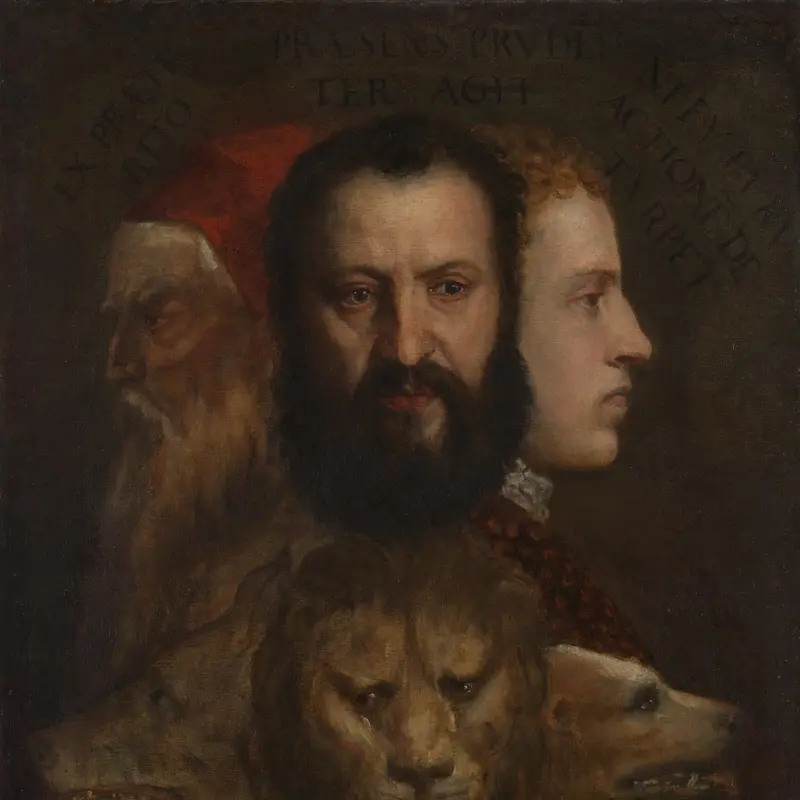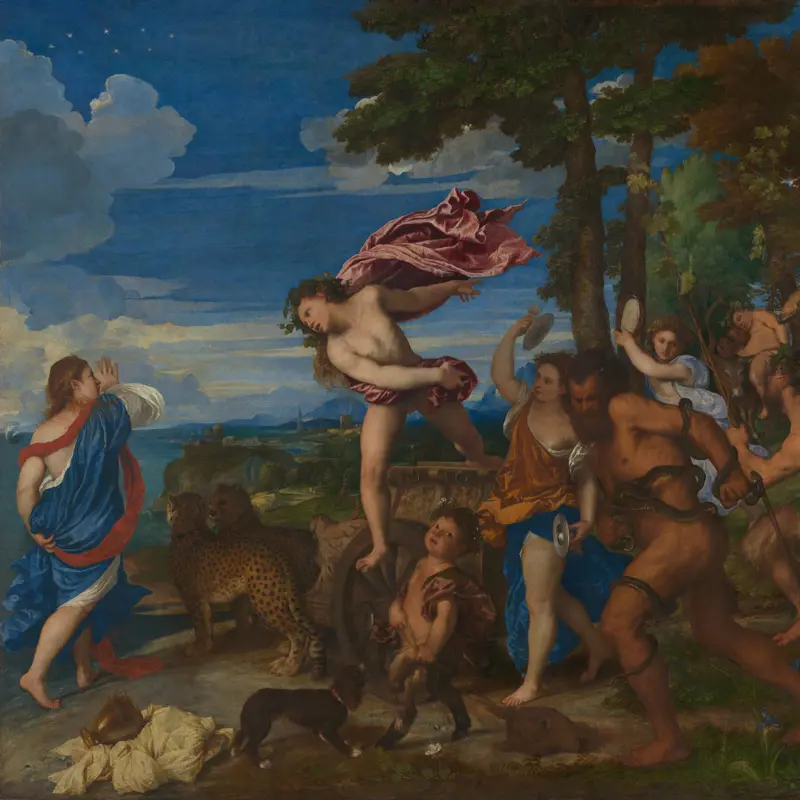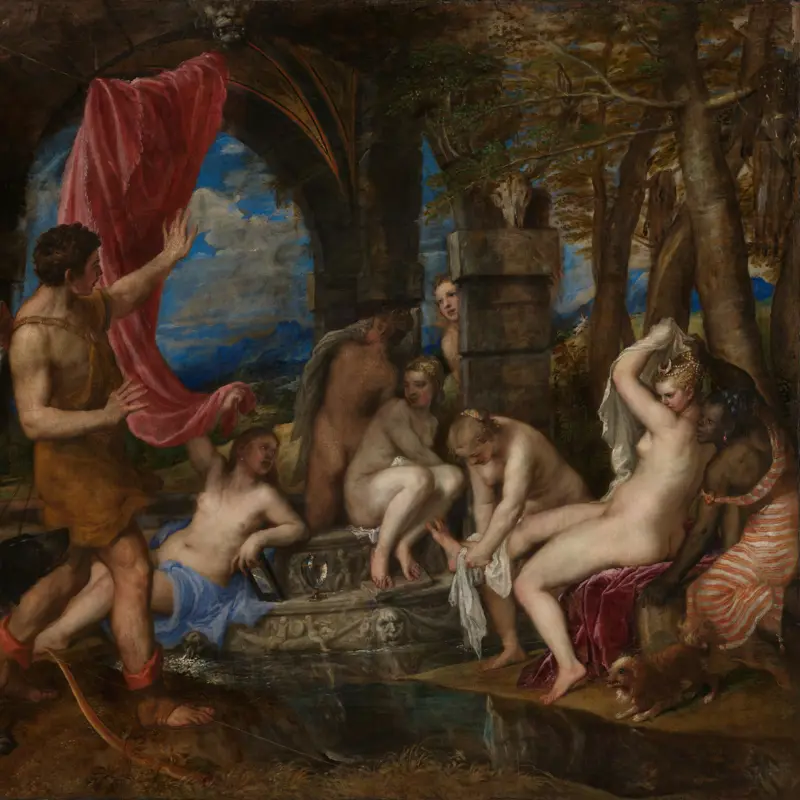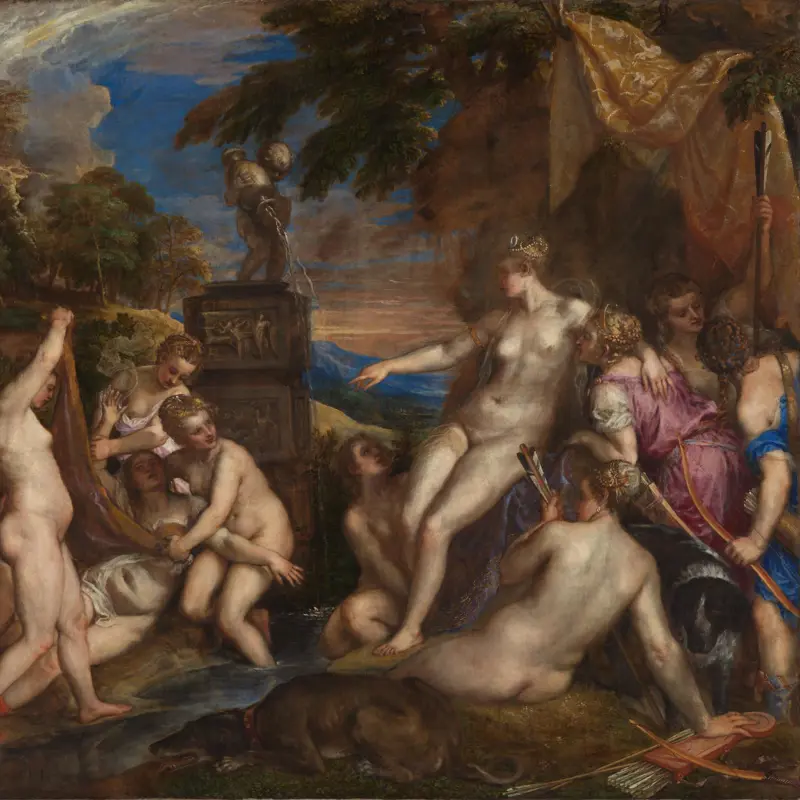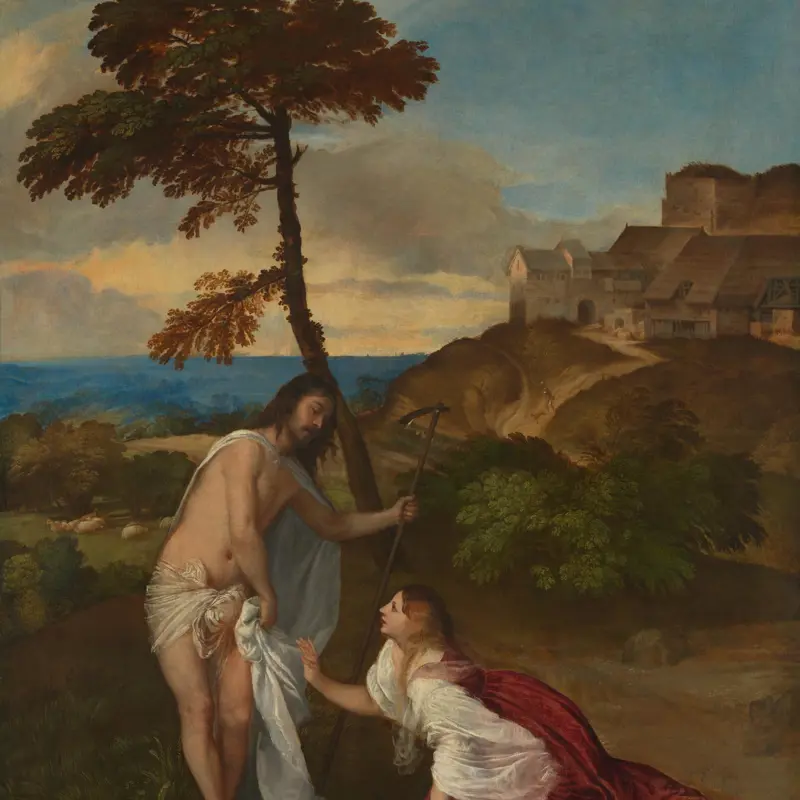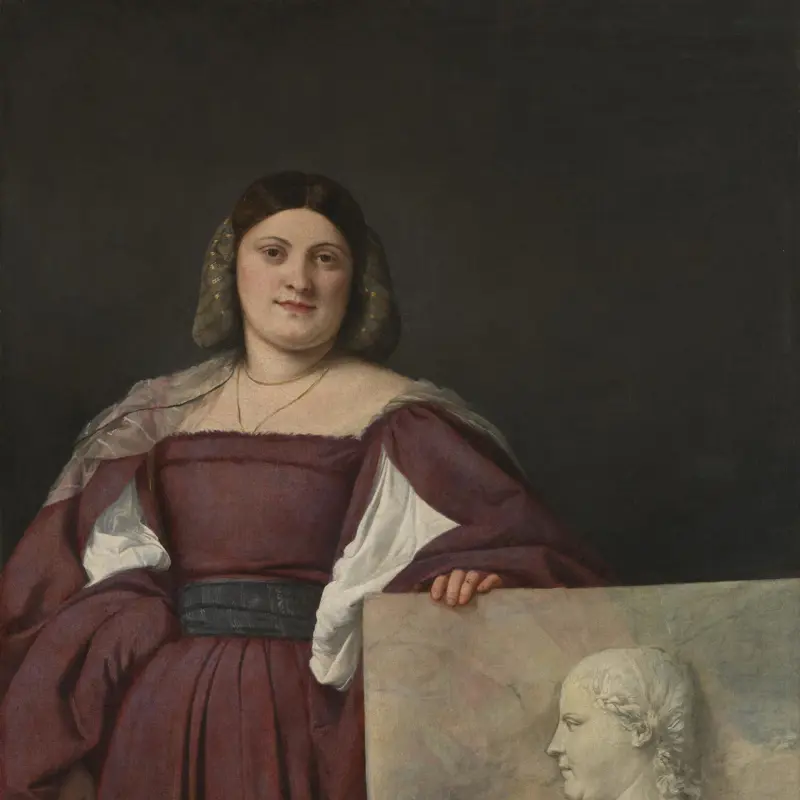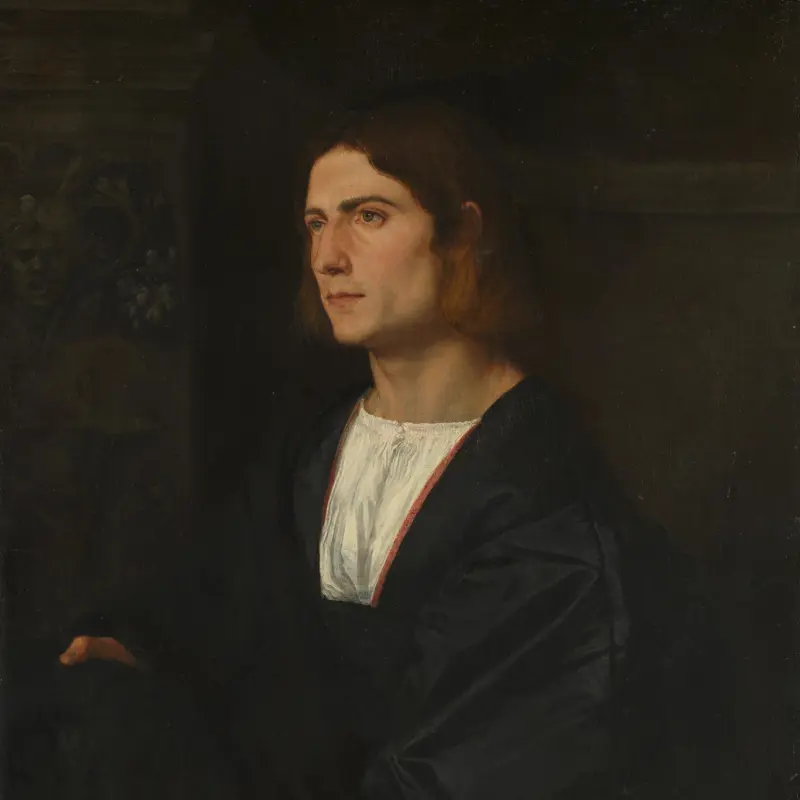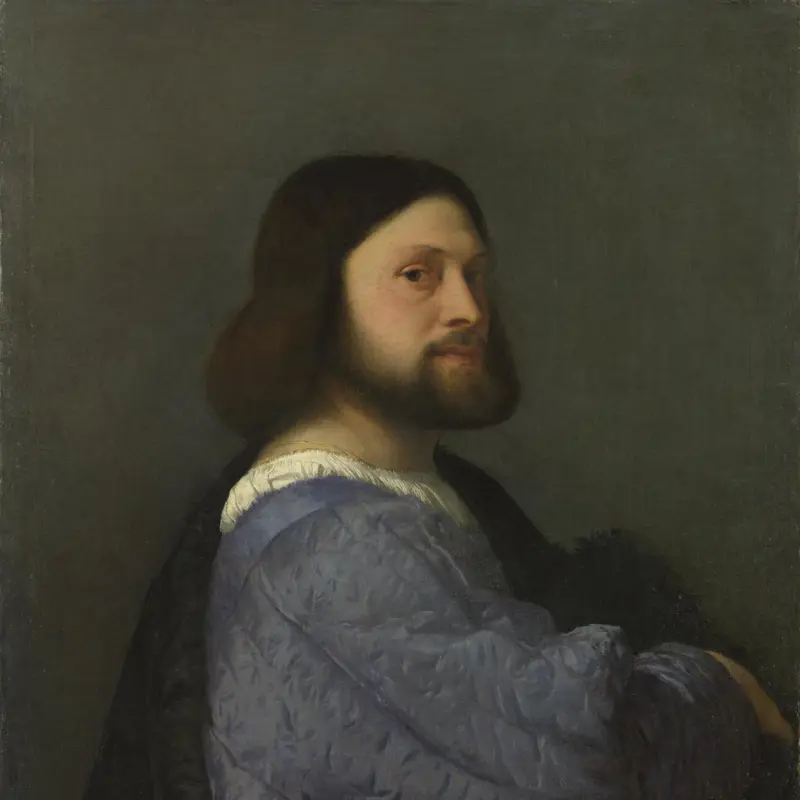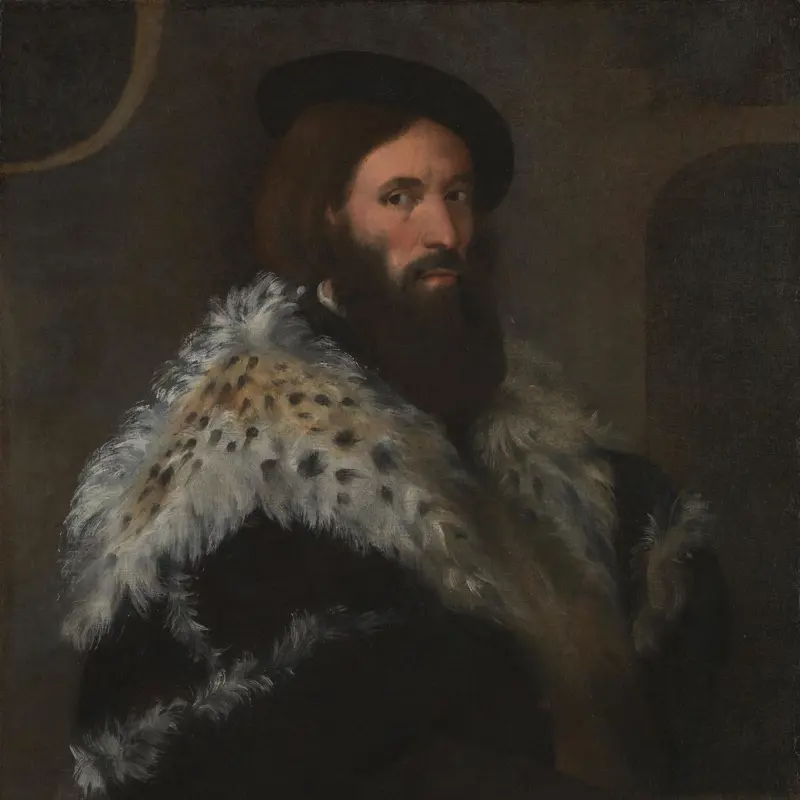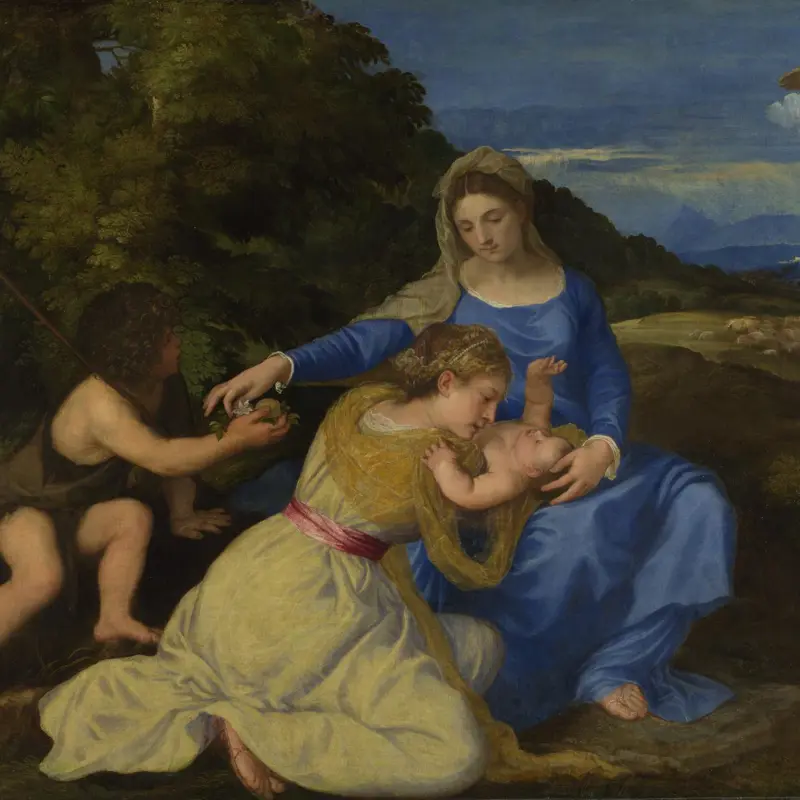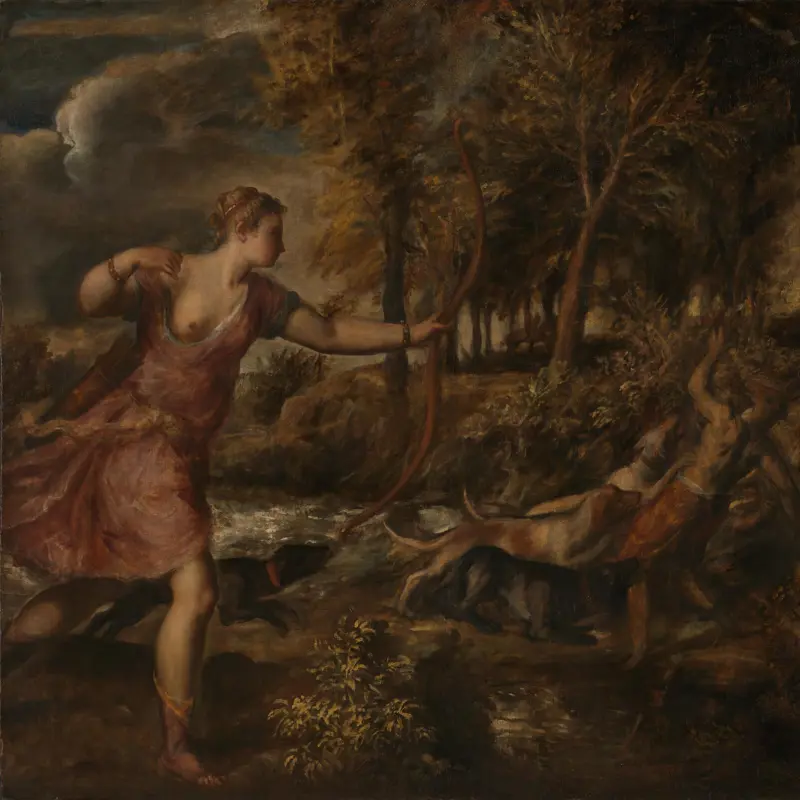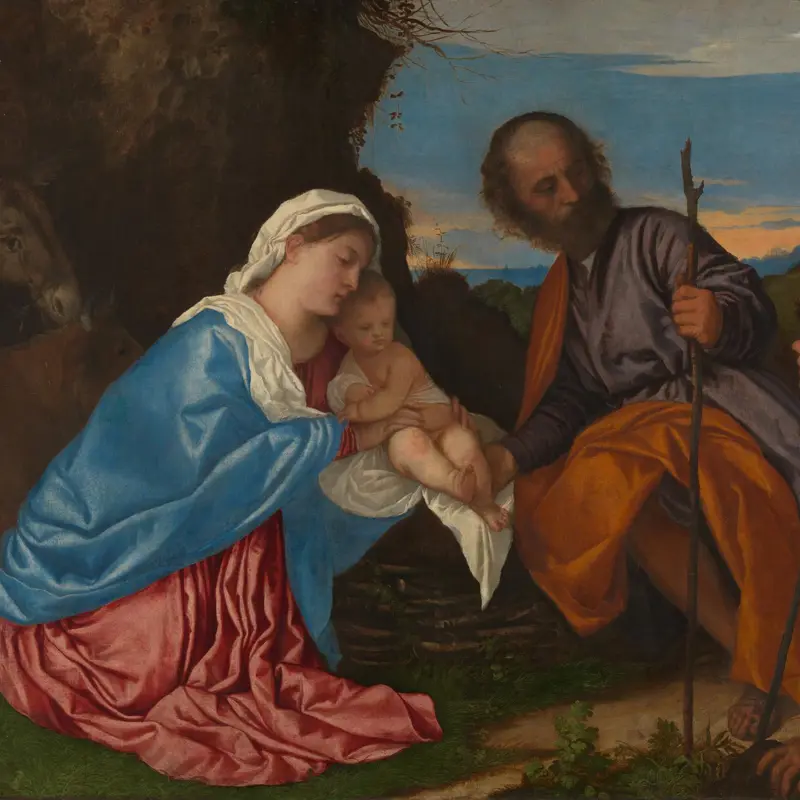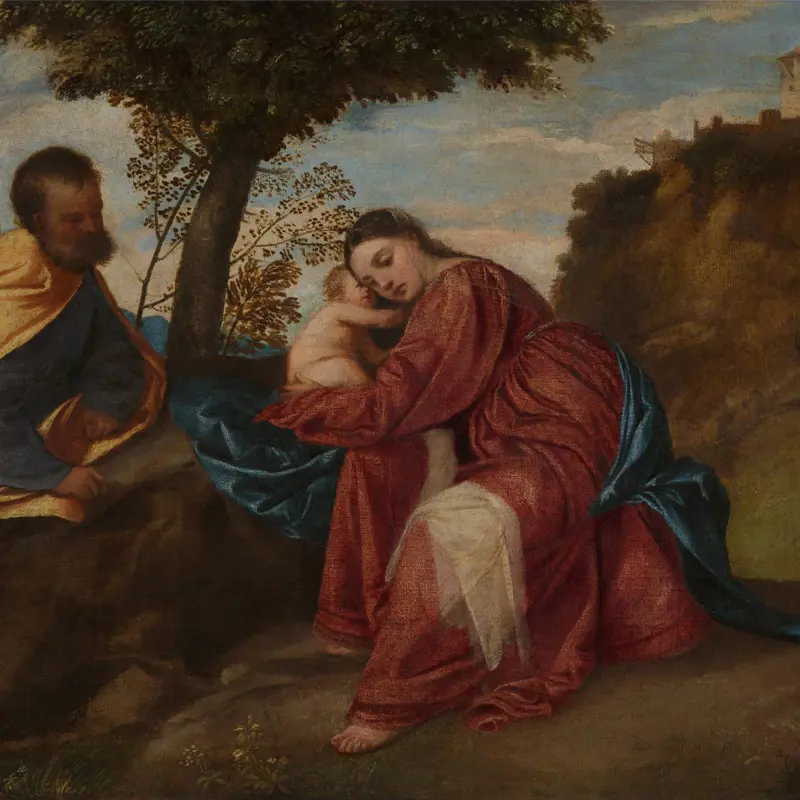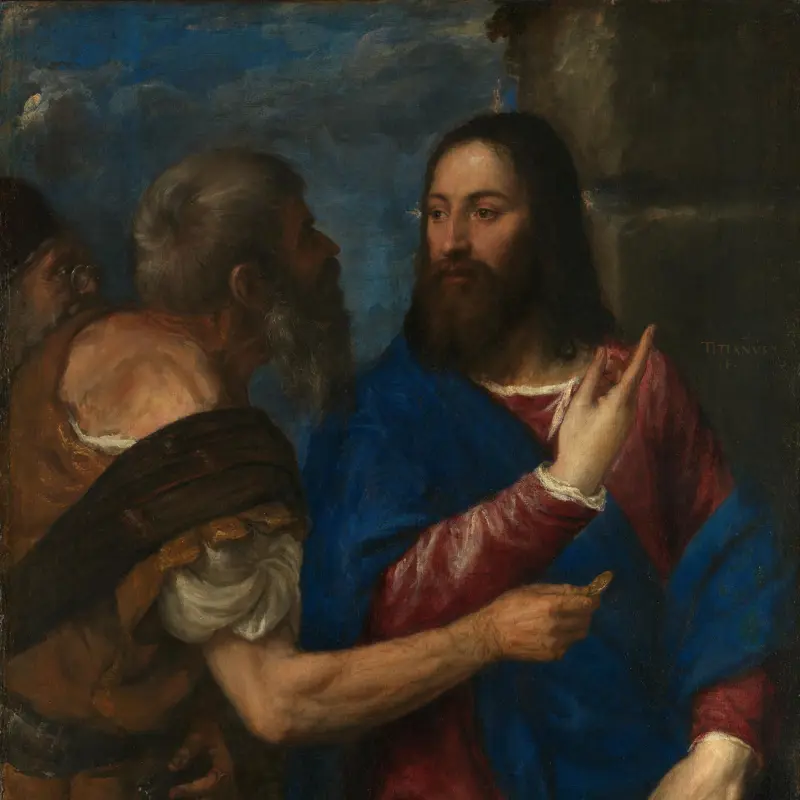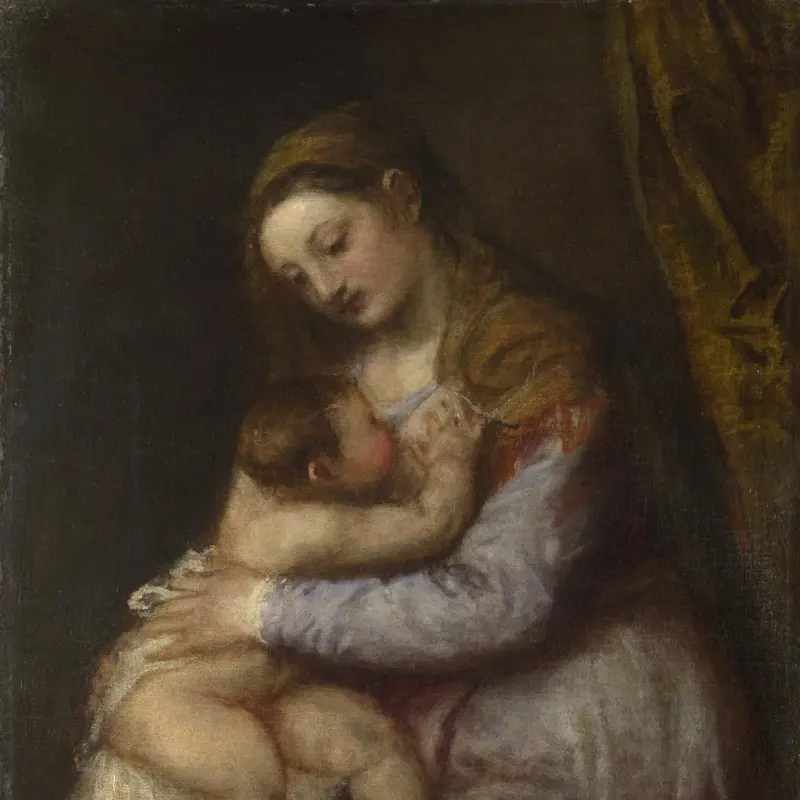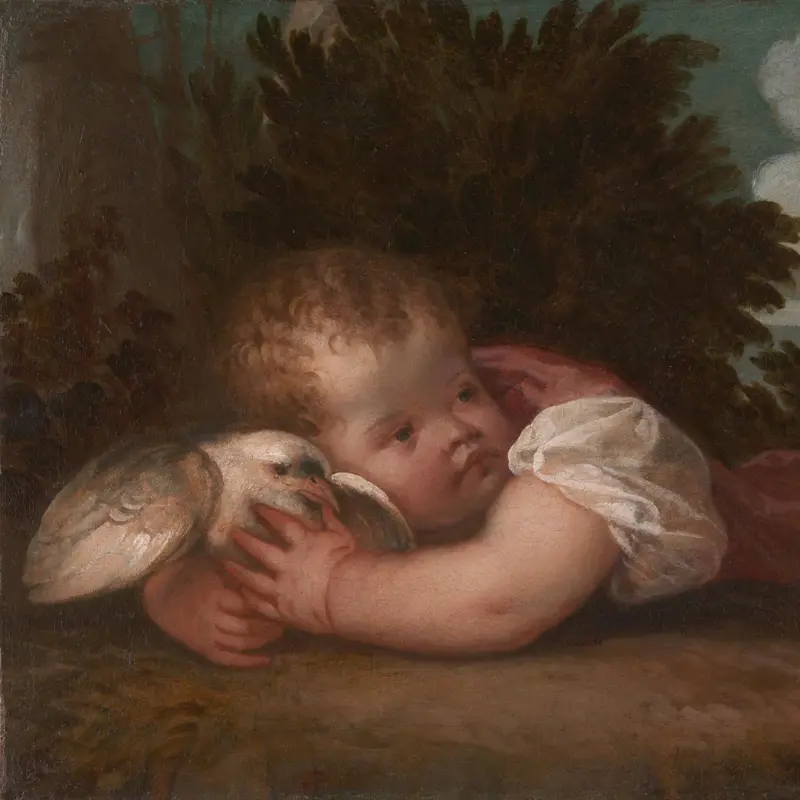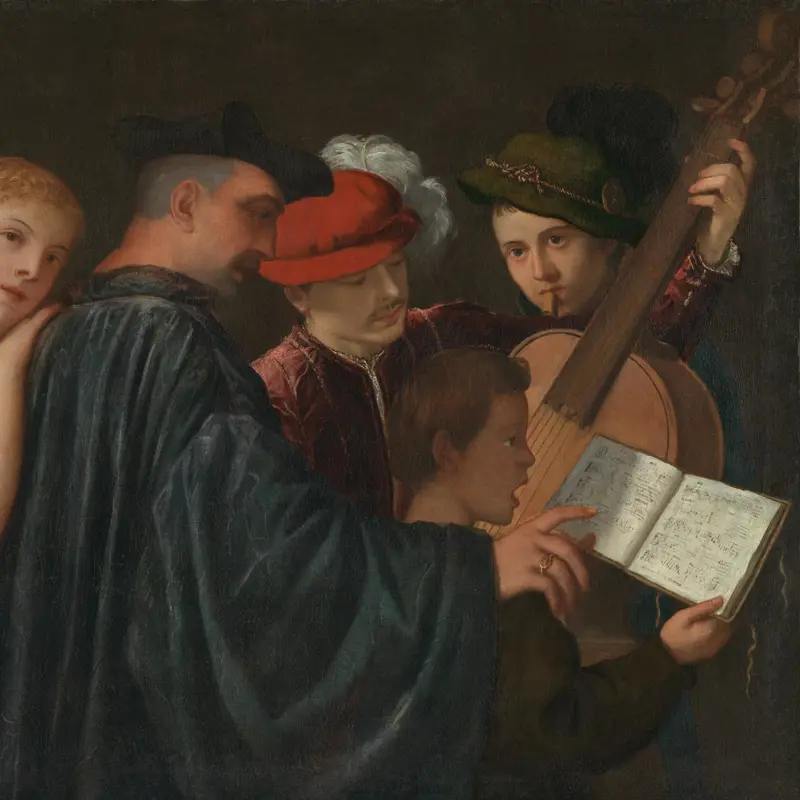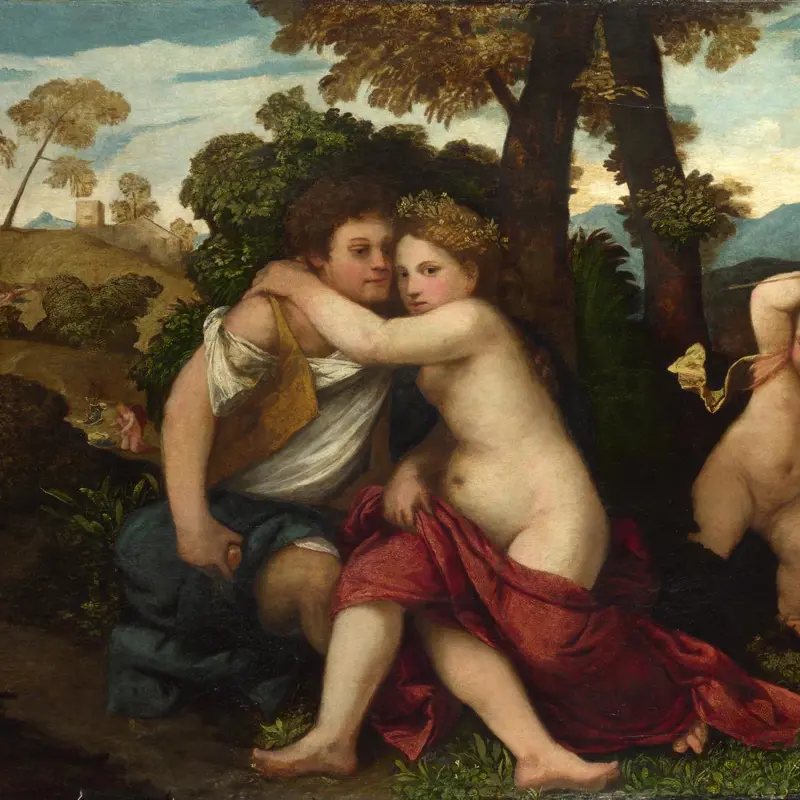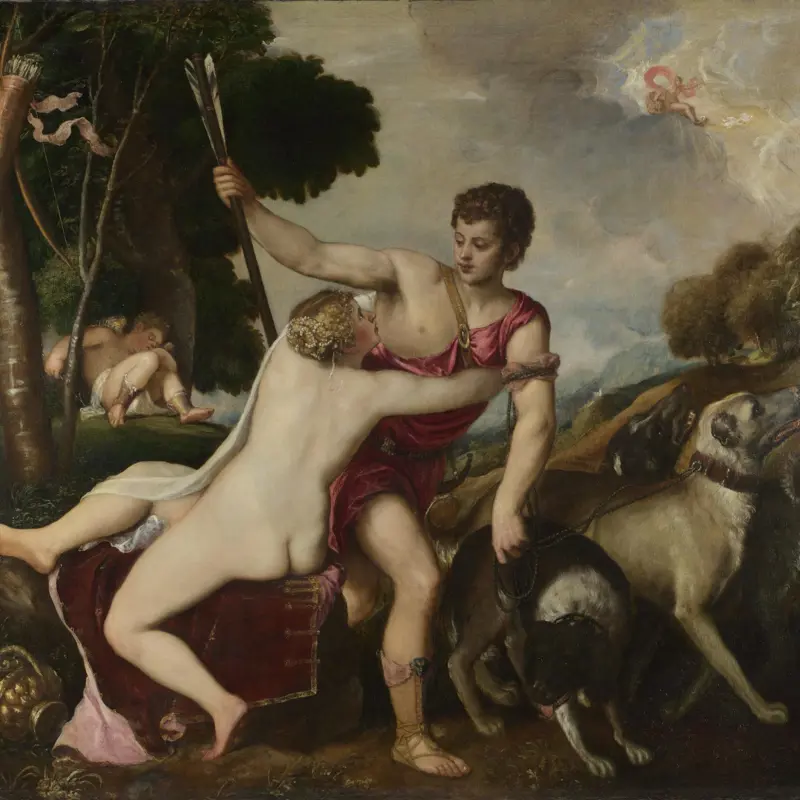Titian, 'The Vendramin Family', about 1540-45
About the work
Overview
This is Titian’s largest group portrait. The man in a red robe is probably Gabriel Vendramin (1484–1552). The man holding the altar may be Gabriel’s brother, Andrea Vendramin (1481–1547), and the boys are his seven sons. On the altar is a reliquary of the True Cross that their great-great-grandfather, an earlier Andrea Vendramin, had received on behalf of the Scuola Grande di S. Giovanni Evangelista in 1369. The relic was the confraternity’s greatest treasure and of great importance to the Vendramin.
The portrait was made for a specific place in the family’s Venetian palace, most likely the central hall. During painting, it was cut down on the left, probably because the patron changed the intended location. The three boys on the far left and two boys on the far right were late additions, possibly painted by an assistant.
Key facts
Details
- Full title
- The Vendramin Family, venerating a Relic of the True Cross
- Artist
- Titian
- Artist dates
- Active about 1506; died 1576
- Date made
- About 1540-45
- Medium and support
- Oil on canvas
- Dimensions
- 206.1 × 288.5 cm
- Acquisition credit
- Bought with a special grant and contributions from Samuel Courtauld, Sir Joseph Duveen, the Art Fund and the Phillips Fund, 1929.
- Inventory number
- NG4452
- Location
- Room 8
- Collection
- Main Collection
- Previous owners
- Frame
- 16th-century Venetian Frame
Provenance
Additional information
Text extracted from the ‘Provenance’ section of the catalogue entry in Nicholas Penny, ‘National Gallery Catalogues: The Sixteenth Century Italian Paintings’, vol. 2, ‘Venice 1540–1600’, London 2008; for further information, see the full catalogue entry.
Exhibition history
-
2016Painters' Paintings: From Freud to Van DyckThe National Gallery (London)23 June 2016 - 4 September 2016
Bibliography
-
1581F. Sansovino, Venetia citta nobilissima et singolare, descritta in 14. Libri da M. Francesco Sansouino. Nella quale si contengono tutte le guerre passate, con l'attioni illustri di molti senatori. Le vite dei principi, & gli scrittori veneti del tempo loro. Le chiese, fabriche, edifici, & palazzi publichi, & priuati. Le leggi, gli ordini, & gli vsi antichi & moderni, con altre cose appresso notabili, & degne di memoria, Venice 1581
-
1725J. Richardson, An Essay on the Theory of Painting, London 1725
-
1769R. Strange, A Descriptive Catalogue of a Collection of Pictures Selected from the Roman, Florentine, Lombard, Venetian, Neapolitan, Flemish, French, and Spanish Schools; to which are Added Remarks on the Principal Painters, etc., London 1769
-
1818British Institution, Catalogue of Pictures by Italian, Spanish, Flemish, Dutch, and French Schools, London 1818
-
1838G.F. Waagen, Works of Art and Artists in England, trans. H. Lloyd, vol. 2, London 1838
-
1846British Institution, Catalogue of the Works of British Artists in the Gallery of the British Institution, Pall-Mall, for Exhibition and Sale, London 1846
-
1854G.F. Waagen, Treasures of Art in Great Britain: Being and Account of the Chief Collections of Paintings, Drawings, Sculptures, Illuminated Mss. […], vol. 2, trans. E. Eastlake, London 1854
-
1877J.A. Crowe and G.B. Cavalcaselle, Titian: His Life and Times, London 1877
-
1898C. Phillips, Titian: A Study of His Life and Work, London 1898
-
1906H.F. Cook, 'Notes on the Study of Titian', The Burlington Magazine, X/44, 1906, pp. 102-8
-
1920A. Ravà, 'Il "Camerino delle anticaglie" di Gabriele Vendramin', Nuovo archivio veneto, XXII/39, 1920, pp. 155-81
-
1925G. Gronau, 'Concerning Titian's Painting at Alnwick Castle', Apollo, II/9, 1925, pp. 126-7
-
1929F.W. Hilles, Letters of Sir Joshua Reynolds, Cambridge 1929
-
1929L. Venturi, 'Letter: The "Cornaro" Titian: An Italian Critic's Opinion', The Times, 1929
-
1930C. Holmes, 'The Italian Exhibition', The Burlington Magazine, LVI/323, 1930, pp. 55-72
-
1930R. Witt and A. Venturi, Exhibition of Italian Art 1200-1900, (exh. cat. Royal Academy of Arts, 1 January - 8 March 1930), London 1930
-
1930R.C. Witt et al., Italian Art: An illustrated Souvenir of the Exhibition of Italian art at Burlington House, London (exh. cat. Royal Academy of Arts, 1 January - 8 March 1930), London 1930
-
1935W. Suida, 'Tizian-Ausstellung in Venedig', Pantheon, XVI, 1935, pp. 219-26
-
1936H. Tietze, Titian: Leben und Werk, 2 vols, Vienna 1936
-
1939P. Pouncey, 'The Miraculous Cross in Titian's "Vendramin Family"', Journal of the Warburg and Courtauld Institutes, II/3, 1939, pp. 191-3
-
1955G.A. Dell'Acqua, Tiziano, Milan 1955
-
1955O. Millar, 'Notes on British Painting from Archives, III', The Burlington Magazine, XCVII/629, 1955, pp. 255-6
-
1957B. Berenson, Italian Pictures of the Renaissance: A List of the Principal Artists and Their Works, with an Index of Places: Venetian School, 2 vols, London 1957
-
1957S. Stone, A Note of the Pictures at Northumberland House Taken and Appraised by Mr Symon Stone the 30th of June 1671, n.p. 1957
-
1959Gould, Cecil, National Gallery Catalogues: The Sixteenth Century Venetian School, London 1959
-
1960F. Valcanover, Tutta la pittura di Tiziano, Milan 1960
-
1962J.R. Judson, 'Dirck Barentsen, "Die… des grooten Titiaens boesem heeft ghenoten"', Bulletin des Musées Royaux des Beaux-Arts de Belgique, XI/1-4, 1962, pp. 77-122
-
1966J. Pope-Hennessy, The Portrait in the Renaissance, New York 1966
-
1969R. Pallucchini, Tiziano, Florence 1969
-
1969H.E. Wethey, The Paintings of Titian: The Religious Paintings, 3 vols, London 1969
-
1975C. Gould, Delaroche and Gautier: Gautier's Views on the 'Execution of Lady Jane Grey' and on other Compositions by Delaroche, London 1975
-
1977M.R. Fisher, Titian's Assistants During the Later Years, New York 1977
-
1977J. Mills and R. White, 'Analyses of Paint Media', National Gallery Technical Bulletin, I, 1977, pp. 57-9
-
1978A. Macintyre and K. Garlick (eds), The Diary of Joseph Farington, vol. 5, New Haven 1978-1984
-
1979J. Anderson, 'A Further Inventory of Gabriel Vendramin's Collection', The Burlington Magazine, CXXI/919, 1979, pp. 639-48
-
1980C. Hope, Titian, London 1980
-
1981B.W. Meijer, 'Titian's Sketches on Canvas and Panel', Master Drawings, XIX/3, 1981, pp. 276-89
-
1982J. Ingamells, '"Perseus and Andromeda": The Provenance', The Burlington Magazine, CXXIV/952, 1982, pp. 396-400
-
1987Gould, Cecil, National Gallery Catalogues: The Sixteenth Century Italian Schools, London 1987
-
1988B. Anatra, Venezia e la Spagna, Milan 1988
-
1990S. Settis and E. Bianchini, Giogione's Tempest: Interpreting the Hidden Subject, Chicago 1990
-
1990C. Brown and N. Ramsay, 'Van Dyck's Collection: Some New Documents', The Burlington Magazine, CXXXII/1051, 1990, pp. 704-9
-
1990J. Wood, 'Van Dyck's "Cabinet de Titien": The Contents and Dispersal of His Collection', The Burlington Magazine, CXXXII/1051, 1990, pp. 680-95
-
1994J. Wood, 'Van Dyck and the Earl of Northumberland: Taste and Collecting in Stuart England', Studies in the History of Art, XLVI, 1994, pp. 280-324
-
1994D. Battilotti, 'Gabriele Vendramin', in R. Maschio (ed.), I tempi di Giorgione, Rome 1994, pp. 226-9
-
1995C. de Benedictis, Per la storia del collezionismo italiano, fonti e documenti, Florence 1995
-
1996R. Godfrey, 'Hollar's Prints for the Earl of Arundel: Copies of Lost Works from the Arundel Collection', Apollo, CXLIV/414, 1996, pp. 36-8
-
1999F. Haskell, 'Venetian Art and English Collectors of the Seventeenth and Eighteenth Centuries', Verona illustrata, 12, 1999, pp. 7-18
-
1999F. Haskell, 'Botticelli, Fascism and Burlington House. The "Italian Exhibition" of 1930', The Burlington Magazine, CXLI/1157, 1999, pp. 462-72
-
2000F. Haskell, The Ephemeral Museum: Old Master Paintings and the Rise of the Art Exhibition, New Haven 2000
-
2001
C. Baker and T. Henry, The National Gallery: Complete Illustrated Catalogue, London 2001
-
2001F. Pedrocco, Titian: The Complete Paintings, London 2001
-
2002E. Longo, 'Commitenza, iconografia e stile nelle croci processionali del Quattrocento Veneziano', Arte Cristiana, XC/811, 2002, pp. 295-302
-
2002R. Lauber, 'Per un ritratto di Gabriele Vendramin: Nuovi contributi', in L. Borean and S. Masons (eds), Figure di collezionisti a Venezia tra Cinque e Seicento, Udine 2002, pp. 25-75
-
2003D. Jaffé (ed.), Titian, London 2003
-
2003J. Dunkerton and M. Spring, 'The Technique and Materials of Titian's Early Paintings in the National Gallery, London', Restoration, III/1, 2003, pp. 9-22
-
2003M. Falomir Faus (ed.), Tiziano (exh. cat. Museo Nacional del Prado, 10 June - 7 September 2003), Madrid 2003
-
2003C. Hope et al., Titian (exh. cat. The National Gallery, 19 February - 18 May 2003; Museo Nacional del Prado, 10 June - 7 September 2003), London 2003
-
2004P. Fortini Brown, Private Lives in Renaissance Venice: Art, Architecture, and the Family, New Haven 2004
-
2007J. Woods-Marsden, Titian: Materiality, Likeness, Istoria, Turnhout 2007
-
2007F. Russell, 'Titian: Canvas Joins and Design', Studi tizianeschi, V, 2007, pp. 182-8
-
2008Penny, Nicholas, National Gallery Catalogues: The Sixteenth Century Italian Paintings, 2, Venice, 1540-1600, London 2008
Frame
This remarkable sixteenth-century Italian frame is made from poplar wood, carved and water-gilt. The back edge is embellished with a raked carved leaf motif. Over a dark blue hollow, spiral-shaped leaves alternate with a pearled ribbon, all diverging from the centres and resting on a row of laurel leaves. The inner edge is richly decorated with a running fruit-and-leaf motif. The sight edge features an acanthus-leaf-and-tongue pattern.
This frame was discovered in Sicily in the 1920s, and was modified to fit this painting.
About this record
If you know more about this work or have spotted an error, please contact us. Please note that exhibition histories are listed from 2009 onwards. Bibliographies may not be complete; more comprehensive information is available in the National Gallery Library.

